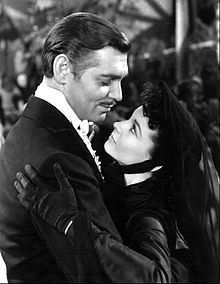(单词翻译:单击)
听力文本
It was a great time for Hollywood. The films had exciting new actors. Spencer Tracy. Bette Davis. Katharine Hepburn. The young Shirley Temple. The most famous film of the period was "Gone with the Wind" with Clark Gable and Vivien Leigh in the starring roles of Rhett Butler and Scarlett O'Hara. "No, I don't think I will kiss you, although you need kissing badly. That's what's wrong with you. You should be kissed, and often, and by someone who knows how." "Oh, and I suppose you think you're the proper person." "I might be. If the right moment ever came." Directors in the nineteen-thirties also produced such great films as "It Happened One Night," "Mutiny on the Bounty," and "The Life of Emile Zola." The success of radio and films, as well as the depression itself, caused problems for many Americans newspapers during the nineteen-thirties.
The trouble was not so much that readers stopped buying newspapers. It was that companies talked about their products through advertisements on radio instead of buying advertising space in newspapers. "Another cup of Maxwell House coffee, George?" "Sure, pour me a cup, Gracie." "You know, Maxwell House is always good to the last drop." Nearly half of the nation's independently-published newspapers either stopped publishing or joined larger companies during the nineteen-thirties. By World War Two, only one hundred-twenty cities had competing newspapers. Weekly and monthly publications faced the same problem as daily newspapers -- increased competition from radio and films. Many magazines failed. The two big successes of the period were Life Magazine and the Reader's Digest. "Life" had stories for everyone about film actors, news events, or just daily life in the home or on the farm. Its photographs were the greatest anywhere. Reader's Digest published shorter forms of stories from other magazines and sources. Most popular books of the period were like the films coming from Hollywood. Writers cared more about helping people forget their troubles than about facing serious social issues. They made more money that way, too.

But a number of writers in the nineteen-thirties did produce books that were both profitable and of high quality. One was Sinclair Lewis. His book, "It Can't Happen Here," warned of the coming dangers of fascism. John Steinbeck's great book, "The Grapes of Wrath," helped millions understand and feel in their hearts the troubles faced by poor farmers. Erskine Caldwell wrote about the cruelty of life among poor people in the southeastern United States, and James T. Farrell and Studs Terkel wrote about life in Chicago. The same social concern and desire to present life as it really existed also were clear in the work of many American artists during the nineteen-thirties. Thomas Benton painted workers and others with strong tough bodies. Edward Hopper showed the sad streets of American cities. Reginald Marsh painted picture after picture of poor parts of New York City. The federal government created a program that gave jobs to artists. They painted their and creativity to millions of people. Indeed, we are proud to have, in the lobby of our VOA building, several such murals by artist Ben Shahn, capturing many facets of the American experience in the nineteen thirties.
At the same time, photography became more important as cameras improved in quality and became smaller and more portable. Some photographers like Margaret Bourke-White and Walker Evans used their cameras to document the difficult conditions of the Depression. The German émigré Alfred Eisenstaedt's photographs of new events and celebrities appeared regularly on the covers of Life. Alfred Stieglitz was another famous photographer in the nineteen thirties. He not only helped to establish photography as an art form, but was influential through his galleries in introducing avant garde artists from Europe to the public. The nineteen thirties were a particularly productive time for landscape photographer Ansel Adams, who also turned to photographing factories and industrial themes. All this activity in the arts and popular culture played an important part in the lives of Americans during the nineteen-thirties. It not only provided relief from their troubles, but expanded their minds and pushed their imaginations. The tensions and troubles of the Great Depression provided a rich atmosphere for artists and others to produce works that were serious or just plain fun. And those works, in turn, helped make life a little better as Americans waited, worked, and hoped for times to improve.
重点解析
1.instead of 代替;取代
We did the logo in lower-case letters instead of capitals.
我们的徽标用了小写字母,没用大写。
2.care about 关心;在乎
I don't care about the matter.
我对这事毫不介意。
3.at the same time 同时;与此同时
I was afraid of her, but at the same time I really liked her.
我害怕她,但同时也确实喜欢她。
4.play an important part in 在……方面起重要作用;在……中起重要作用
He play an important part in the development of the French nuclear power programme.
他在法国核动力规划的开发中起了重要的作用。
参考译文
那是好莱坞的好时光。这些电影中有了令人兴奋的新演员。斯宾塞·特蕾西、贝蒂·戴维斯、凯瑟琳·赫本、年轻的雪莉·坦普尔。这一时期最著名的电影是《乱世佳人》,由克拉克·盖博和费雯丽出演瑞德·巴特勒和斯嘉丽·奥哈拉。“不,我想我不会吻你,尽管你很需要亲吻。这是你的错,你应该经常被人亲吻,而且应该经常被一个知道怎么接吻的人亲吻。”“我想你认为你是合适的人选。”“我可能是,如果时机成熟的话。”20世纪30年代的导演们还制作出《一夜情》、《赏金叛变》和《左拉的生活》等伟大的电影。广播和电影的成功,以及经济大萧条,在20世纪30年代给许多美国报纸带来了问题。
问题并不在于读者停止购买报纸,而是因为各个公司都通过广播广告来谈论产品,而不是在报纸上购买广告版面。“再来一杯麦斯威尔咖啡,乔治?”“当然,给我倒一杯,格雷西。”“麦斯威尔咖啡,滴滴香浓。”“那一滴也不错。”20世纪30年代,美国近一半独立出版的报纸要么停止出版,要么加入大型公司。到二战时,只有120个城市还有相互竞争性的报纸。周刊和月刊面临着和日报一样的问题,即来自广播和电影的竞争加剧。许多杂志都停刊了,这一时期两本成功的杂志是《生活》杂志和《读者文摘》。《生活》杂志为读者提供关于电影演员、新闻事件、家庭或农场日常生活的故事,其中的照片绝妙至极。《读者文摘》出版来自其他杂志和来源的短篇小说。那个时期最受欢迎的书就像好莱坞的电影,作家更关心的是帮助人们忘记烦恼,而不是面对严重的社会问题。这样他们也赚到更多钱。
但是,在20世纪30年代,一些作家确实出版了既赢利,质量又高的书籍。一位是辛克莱·刘易斯,他的书《不会发生在这里》警告了法西斯主义即将到来的危险。约翰·斯坦贝克的巨著《愤怒的葡萄》帮助数百万人理解和感受到贫苦农民所面临的困难。厄斯金·考德威尔描写的是美国东南部穷人的残酷生活,詹姆斯·托·法雷尔和斯特兹·特克尔描写的则是芝加哥的生活。20世纪30年代,许多美国艺术家的作品中也清晰地展示出同样的社会关注和对现实生活的渴望。托马斯·本顿把工人和其他人描绘成具有强壮而坚韧的身体。爱德华·霍珀展示出美国城市的凄惨街道,雷金纳德·马什描画了一幅幅纽约市贫困地区的画作。联邦政府设立了一个项目,为艺术家提供就业机会。他们向数百万人描绘出他们的创造力。事实上,我们很自豪,在美国之音大楼的大厅里,有几幅这样的壁画,由艺术家本·沙恩创作,捕捉到美国人在20世纪30年代经历的许多方面。
与此同时,随着相机质量的提高,其体积越来越小,更便于便携,摄影变得更为重要。一些摄影师,如玛格丽特·伯克·怀特和沃克·埃文斯,用他们的相机记录了大萧条时期的艰难状况。德国移民阿尔弗雷德·艾森斯塔特的新事件和名人照片,定期出现在《生活》杂志的封面上。阿尔弗雷德·斯蒂格利茨是20世纪30年代另一位著名的摄影师。他不仅帮助将摄影确立为一种艺术形式,而且非常具有影响力,他借助自己的画廊将来自欧洲的前卫艺术家介绍给公众。20世纪30年代是风景摄影师安塞尔·亚当斯特别富有成就的时期,他也转向拍摄工厂和工业主题。所有这些在艺术和流行文化方面的活动,在20世纪30年代的美国人生活中扮演着重要的角色。它不仅使人们摆脱烦恼,而且扩展他们的思想,推动他们的想象力。大萧条时期的紧张和困境,为艺术家和其他人创作严肃或纯粹有趣的作品提供了丰富的氛围。而这些作品,反过来,帮助人们使生活变得更好,因为美国人在等待、在工作,并希望时代进步。
译文为可可英语翻译,未经授权请勿转载!


